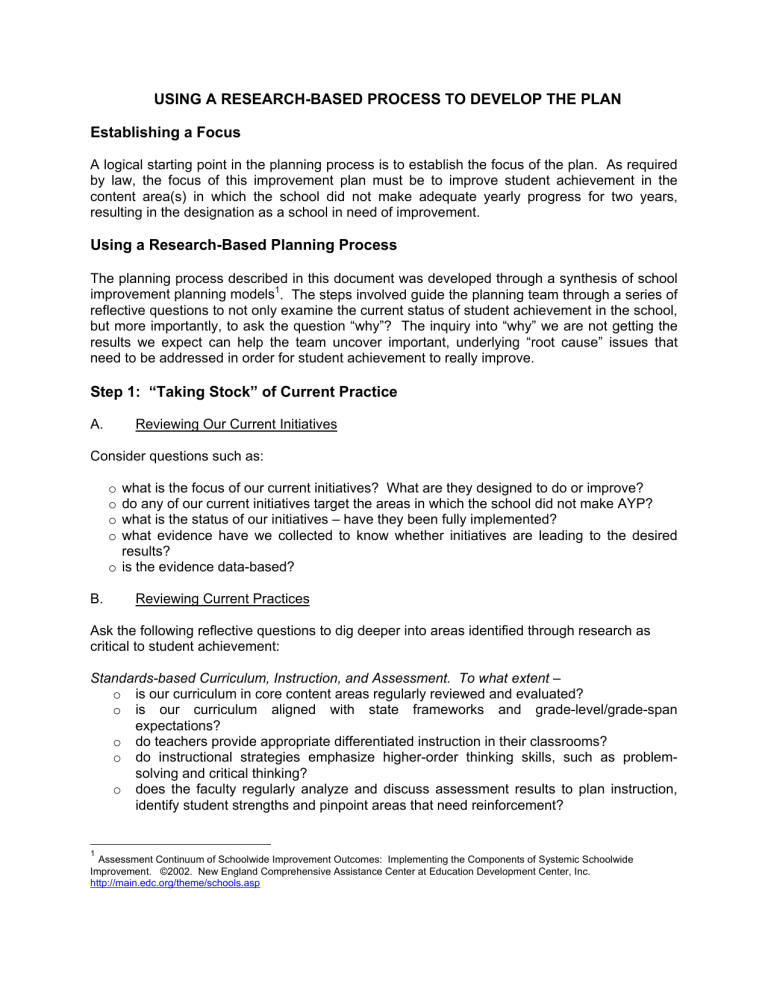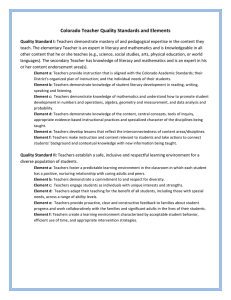USING A RESEARCH-BASED PROCESS TO DEVELOP THE PLAN Establishing a Focus

USING A RESEARCH-BASED PROCESS TO DEVELOP THE PLAN
Establishing a Focus
A logical starting point in the planning process is to establish the focus of the plan. As required by law, the focus of this improvement plan must be to improve student achievement in the content area(s) in which the school did not make adequate yearly progress for two years, resulting in the designation as a school in need of improvement.
Using a Research-Based Planning Process
The planning process described in this document was developed through a synthesis of school improvement planning models
1
. The steps involved guide the planning team through a series of reflective questions to not only examine the current status of student achievement in the school, but more importantly, to ask the question “why”? The inquiry into “why” we are not getting the results we expect can help the team uncover important, underlying “root cause” issues that need to be addressed in order for student achievement to really improve.
Step 1: “Taking Stock” of Current Practice
A. Reviewing Our Current Initiatives
Consider questions such as: o what is the focus of our current initiatives? What are they designed to do or improve? o do any of our current initiatives target the areas in which the school did not make AYP? o what is the status of our initiatives – have they been fully implemented? o what evidence have we collected to know whether initiatives are leading to the desired results? o is the evidence data-based?
Ask the following reflective questions to dig deeper into areas identified through research as critical to student achievement:
Standards-based Curriculum, Instruction, and Assessment. To what extent – o is our curriculum in core content areas regularly reviewed and evaluated? o is our curriculum aligned with state frameworks and grade-level/grade-span expectations? o do teachers provide appropriate differentiated instruction in their classrooms? o do instructional strategies emphasize higher-order thinking skills, such as problemsolving and critical thinking? o does the faculty regularly analyze and discuss assessment results to plan instruction, identify student strengths and pinpoint areas that need reinforcement?
1
Assessment Continuum of Schoolwide Improvement Outcomes: Implementing the Components of Systemic Schoolwide
Improvement. ©2002. New England Comprehensive Assistance Center at Education Development Center, Inc. http://main.edc.org/theme/schools.asp
Accountability. To what extent - o do we disaggregate student achievement data to follow the progress of each student? o do we systematically identify and provide appropriate supports to struggling learners? o do we use disaggregated student achievement results to prioritize professional development? o do we analyze program effectiveness in order to plan instruction and set priorities? o do we annually share assessment results through newsletters, PTO meetings, local press releases, and the school/district web page? o do we provide such information, to the extent possible, in languages that parents can understand?
Structural reform strategies. To what extent – o are structured planning opportunities for staff a regular part of the school schedule? o are teachers provided with the opportunity to plan their work collaboratively? o is support for novice teachers available? o is uninterrupted time dedicated each day and week to instruction in core areas? o have there been significant changes in staff, teaming structures, leadership structures, or enrollment?
Leadership and governance. To what extent – o has the school used an improvement plan with measurable goals to guide its work? o is shared leadership evident, as appropriate, to support and improve instruction?
Professional development. To what extent – o is professional development aligned with curricular priorities and student achievement goals? o are professional development opportunities available to paraprofessionals so to ensure
consistency in knowledge and practice among all instructional staff?
Culture and climate. To what extent – o are disciplinary issues interfering with instructional time? o do teachers work independently rather than collaboratively? o is collaboration and reflective practice valued?
External support and resources. To what extent – o is the school aware of federal resources received at the district level that could be leveraged to support its improvement plan? o are partnerships with businesses or organizations actively supporting the school’s improvement goals?
Parent and community involvement. To what extent – o are parents and community members familiar with what students are expected to know, do, and demonstrate, and what they can do to support their child’s achievement? o are resources, tools, or training provided to help parents support their child’s learning?
Extended learning activities. To what extent – o are extended-learning activities available at our school? o are students most in need participating?
2
Step 2: What Results Are We Getting? What are Possible Reasons Why?
After reviewing and discussing current efforts and practices, the next step is to look at the results of student assessments to determine: o To what extent is each student meeting the state performance targets in Reading/Math? o To what extent is each student group represented on the AYP report meeting the targets? o Are there patterns or trends? Do these patterns hold up over time? o Why, despite all of our efforts and initiatives, are we not getting the results we want? o What factors or conditions are getting in the way? How do we know?
How to know what factors or conditions are getting in the way? After brainstorming the possible
“root cause” issues, the team will need to differentiate between those that are unsubstantiated hunches and those that are not. This analysis is important to assure that the issues selected as priorities for the plan can be supported with evidence. For example, if the “CHECK ENGINE” light remains on after starting a vehicle, is it because of a minor electronic malfunction or is it because of something else? The “CHECK ENGINE” light is just a symptom of a problem.
“Digging deeper” will help the team discover the actual “root” of the problem.
What is a “Root Cause”?
In the “School Leader’s Guide to Root Cause Analysis: Using Data to Dissolve Problems ”
2
,
Paul Preuss defines a root cause as “... the deepest underlying cause, or causes, of positive or negative symptoms within any process that,if dissolved, would result in elimination, or substantial reduction, of the symptom (p.3). Preuss goes on to highlight key words:
Deepest – this means that we need to look beyond the obvious and to continue to question and dig deeper into what we see.
Cause or causes – education is a complex social system. As such the symptoms that we experience usually have more than one root cause that act in combination to bring about the results. “ The good news is that often, by dissolving any one of the multiple root causes, the symptoms can be reduced or even eliminated ” (p.4).
Positive or negative – Root causes can be found for both failures as well as successes.
Understanding successes can contribute to identifying effective strategies that may work to address negative symptoms.
Symptoms – Symptoms are the “red flag” that draw attention to the gap between expected desired outcomes and the reality.
Process – Everything we do involves process. At its most basic, a simple process consists of input, added value, and output.
Dissolve – The purpose of root cause analysis is to identify the root cause(s) of a symptom, and, where the symptom is negative or undesirable, to find ways to dissolve the root rather than simply patching up and/or hiding the symptom.
2
2
Preuss, P.G. (2003). School Leader’s Guide to Root Cause Analysis: Using Data to Dissolve Problems.
www.eyeoneducation.com
3
Step 3: Setting Goals and Achievable Objectives
Once the team has identified the core issues to be addressed to improve student achievement, the next step is to determine priorities. What to work on first? What to work on over time?
What will we look for as signs of positive change? For this two-year plan, establish goals and objectives that can be achieved within a two-year time frame, and target “root cause” issues within the school’s control.
Step 4: Selecting Strategies and Activities for Implementation
This step involves determining which strategies and activities, supported through research, the school will implement in order to address the identified issues. Points to consider include: o the rationale for the strategy – how will it help? o in what settings and for which populations has the strategy been effective? o is the strategy appropriate/feasible for our situation? o is there credible research demonstrating the strategy’s effectiveness?
4
EXAMPLE OF THE PLANNING PROCESS FOR THE ABC TEAM
Step 1: “Taking Stock” of Current Practice
Step 2: What Are the Results? What are Possible Reasons Why?
The ABC School Planning Team determined that achievement in mathematics for students with disabilities had been a concern for some time. By “digging deeper”, the team identified and explored a number of possible contributing factors:
• the mathematics curriculum is not fully aligned with state grade-level expectations
• students miss core instruction when pulled out to work with specialists
• a structure is needed for general and special educators to regularly collaborate on instruction
• professional development has been devoted to other priorities
• training for paraprofessionals providing direct instruction is inconsistent
Step 3: Setting Goals, Strategies, and Achievable Objectives
These issues provided the rationale for selecting the following strategy and objectives:
Goal:
Using fall 2007 NECAP results as the baseline, all student groups will make progress
towards state performance targets in Math, as evidenced by local/state assessments.
Strategy:
As one of several strategies designed to achieve this goal, prioritize alignment of math curriculum with GLEs/GSEs.
Objectives: (How will teacher practice and student experience change? What will we look for?) o Teachers will learn to use the aligned curriculum to develop their unit plans o Students will be exposed to a curriculum aligned to the state/local GLEs/GSEs.
Step 4: Selecting Activities for Implementation
The school will implement the following activities to meet these objectives: o continue alignment of mathematics curriculum with grade-level expectations o review and revise student schedules so that instructional time in mathematics is not lost o prioritize professional development planned for 2008-09 with priority needs in mathematics identified through this improvement plan; o request assistance from a NHDOE special education technical assistance consultant to design a collaborative planning process for general and special educators
5


